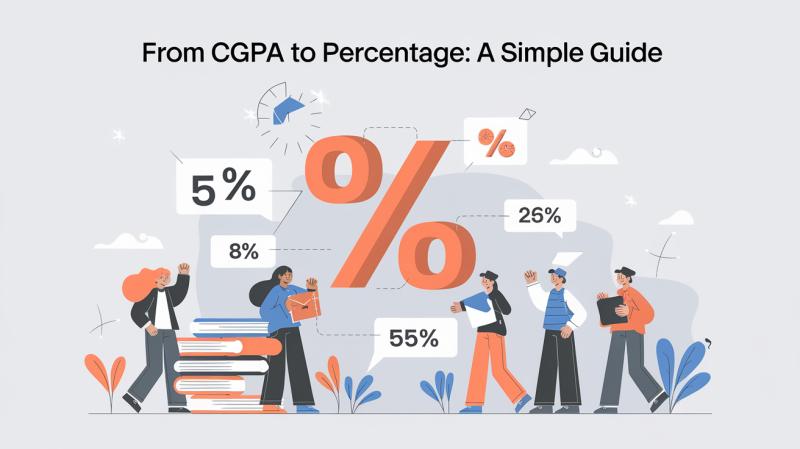CGPA to Percentage Conversion: A Simple Guide

Everyone remembers that feeling of staring at their CGPA and wondering, “What’s my actual percentage?” Especially when job applications and college admissions come knocking, and you’re left to translate one scale into another. Let’s not make it more complicated than it needs to be. We’ll cut straight to the basics and show you exactly how to get from CGPA to percentage without breaking a sweat.
Key Takeaways
- CGPA to Percentage Formula: Multiply your CGPA by 9.5 to get your percentage.
- Understand Variations: Some institutions use a different multiplier, so double-check if you’re applying somewhere specific.
- Why 9.5?: The multiplier is based on standardized data from educational boards. It’s there to make the process fair.
- Practical Use: Converting CGPA to percentage can be essential for job applications or university admissions.
Why Convert CGPA to Percentage?
Some schools, colleges, and companies still measure performance in percentage terms, and they’ll want your grades that way. While CGPA (Cumulative Grade Point Average) might be what’s on your report card, it doesn’t always speak the language of employers or college admissions.
Most universities, especially abroad, consider CGPA as the standard grading system. But in India, where the system is mixed, you’ll often need to have both CGPA and percentage handy.
Step-by-Step Guide: Converting CGPA to Percentage
Now, here’s how you get from CGPA to percentage. This process isn’t a complicated formula you need to memorize. It’s simple math, and anyone can do it.
1. Know the Basic Formula
The most common formula for converting CGPA to percentage is:
Percentage (%) = CGPA × 9.5
That’s it. Just take your CGPA and multiply it by 9.5. Why 9.5? It’s a standardized multiplier that many Indian educational boards use based on a study of average scores.
Let’s break it down:
If your CGPA is 8.0, then your percentage is:
8.0 × 9.5 = 76%
If your CGPA is 7.5, then your percentage is:
7.5 × 9.5 = 71.25%
This formula works for most boards and colleges in India, but always check if the institution has its own specific multiplier.
2. Variations Across Institutions
While the 9.5 rule is widespread, some universities use different multipliers, such as 10 or even 9.0. So, check if your school or employer has a specific rule.
Example Conversions
Here’s how it looks when put into practice. Let’s say you’ve got a CGPA, but you need to know how it translates into a percentage. Here’s a quick reference for common CGPAs:
- 10 CGPA = 95%
- 9 CGPA = 85.5%
- 8 CGPA = 76%
- 7 CGPA = 66.5%
- 6 CGPA = 57%
You see how easy it is? Just multiply and you’re done. For instance, if you’re wondering about a CGPA of 7.8, then:
7.8 × 9.5 = 74.1%
Why 9.5? The Story Behind the Multiplier
You might wonder why 9.5 and not any other number. It’s not random. Indian boards like the CBSE did studies on past student performances, analyzing CGPAs and corresponding percentages. The 9.5 multiplier was found to be an accurate average.
Other boards or universities might land on 9.0 or 10.0 for their own reasons. For example, engineering schools often go with 10 as the multiplier, keeping things simpler but slightly inflating the percentage. This isn’t something to overthink, though. Just know which multiplier you need for your specific case.
The Importance of a Standardized Multiplier
Using a standardized multiplier like 9.5 isn’t just a convenience. It levels the playing field, helping employers or admissions committees get a consistent measure of performance. With CGPA, even small changes make a big impact on a percentage score. A difference of 0.1 in CGPA can mean almost a full percentage point shift.
So, when you’re converting, stick with the multiplier expected. It’s one less thing to worry about when you’re applying to places where percentages matter.
Tips for Handling CGPA and Percentage Conversions
If you’re dealing with CGPA regularly, here are a few tips that can make things easier.
- Stick with 9.5 unless told otherwise. It’s the safest bet in most scenarios.
- Know your institution’s rules. Some colleges, especially outside India, have specific CGPA scales. Convert accurately.
- Keep records of both formats. Have your CGPA and percentage ready to avoid last-minute conversions.
- Understand that CGPA is an average. CGPA captures your overall performance. Don’t sweat individual scores; focus on the final number.
Quick Reference: CGPA to Percentage Table
Here’s a cheat sheet for converting some common CGPAs:
| CGPA | Percentage |
|---|---|
| 10.0 | 95% |
| 9.5 | 90.25% |
| 9.0 | 85.5% |
| 8.5 | 80.75% |
| 8.0 | 76% |
| 7.5 | 71.25% |
| 7.0 | 66.5% |
| 6.5 | 61.75% |
| 6.0 | 57% |
This table should give you a rough idea of where you stand without having to do math on the spot.
Final Thoughts
Converting CGPA to percentage doesn’t need to feel like a hurdle. It’s about knowing the right formula and applying it when you need it. Stick to 9.5 for most cases, but don’t be afraid to double-check if an institution expects something different. It’s a simple skill, but it’s one that opens doors, especially in a world that hasn’t fully transitioned from percentage to CGPA yet.
Recap:
- Formula: CGPA × 9.5 = Percentage
- Why 9.5: Standardized by Indian boards for accuracy
- Check for Variations: Some institutions use 10 or 9.0 as multipliers
- Keep Records: Have both CGPA and percentage ready
- Use the Multiplier Needed: Stick to what’s expected in applications
So next time you see a CGPA, don’t hesitate. Multiply, check, and move forward. It’s a small thing, but it keeps your path smooth, whether you’re applying for jobs, higher education, or anything in between.
Post Your Ad Here


Comments